Systematic oil flow modeling in the Quasi-3D approximation yields additional terms that allows for variable cross-section area tubing
作者机构:Laboratory for Devices and NanostructuresEngineering at the Nanometer Scale GroupUniversidade Federal de Pernambuco-UFPERecifeBrazil
出 版 物:《Petroleum》 (油气(英文))
年 卷 期:2021年第7卷第1期
页 面:53-63页
核心收录:
学科分类:0820[工学-石油与天然气工程] 08[工学] 082002[工学-油气田开发工程]
基 金:This work was partly funded by CNPq Brazilian funding agency and by PETROBRAS Brazilian Oil Company
主 题:Conservation equation Flow model Two-phase flow Ramey’s model Hasan’s model
摘 要:A systematic model development for oil flow in quasi-3D(1Dþ2D)is *** approach provides a unified modeling ***,additional terms are obtained,which allows for tubing area variation along the flow *** area variation can be modeled as analytic function or random fluctuation,as it could be the result of deposits or tubing internal surface *** proposed approach can be used to obtain analytic solutions which provide physical insight into the phenomena under scrutiny,including the validation of software tools,sensor development and sensor *** starts from conservation laws as given by kinetic theory and applies the transverse averaging technique(TAT)to extract the one-dimensional approximation in formal *** demonstrate its application,the steady-state Ramey’s model,the Hasan’s transient model and a simple two-phase model are generated from the obtained equations.



